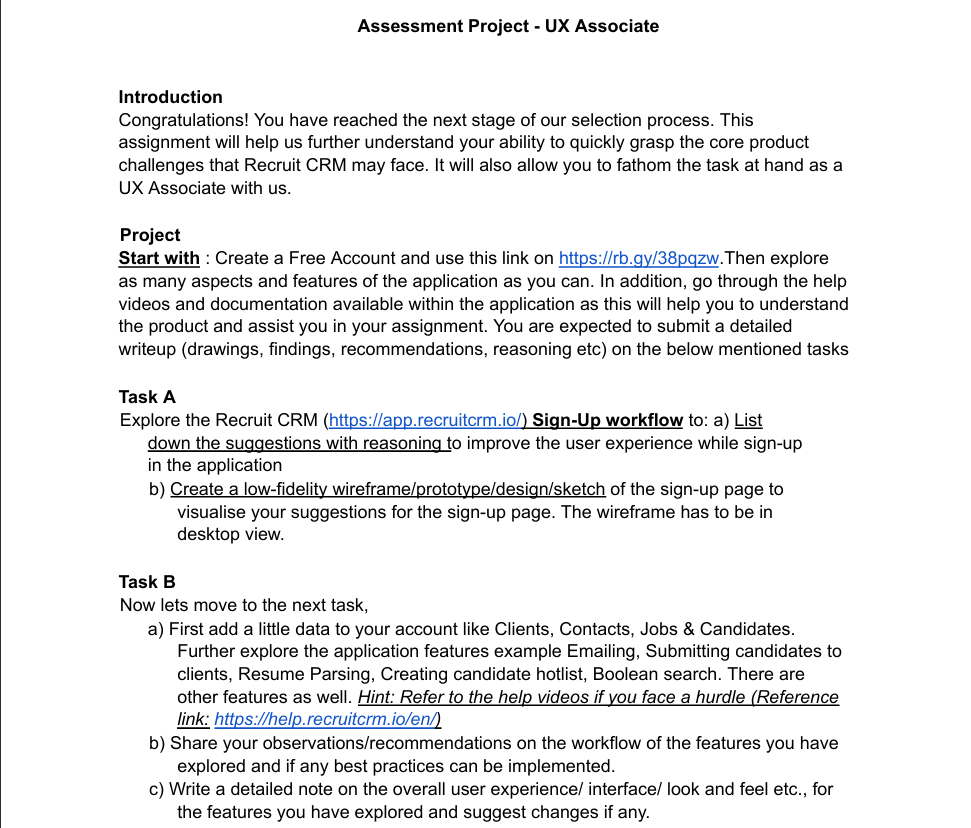Project Overview
- Objective: Improve the user experience (UX) and interface (UI) of Recruit CRM's sign-up workflow and other key features.
- Deliverables: Suggestions, wireframes, observations, and a detailed write-up.
Task A: Explore the Recruit CRM Sign-Up Workflow
a) Suggestions to Improve the Sign-Up Experience
Simplified Form Fields:
- Reduce the number of mandatory fields in the initial step. Example: Ask for only Name, Email, and Password initially.
- Reasoning: Minimizes friction and encourages user completion.
Progress Indicator:
- Add a step-by-step progress bar if the sign-up involves multiple steps.
- Reasoning: Gives users a sense of control and awareness of the process.
Instant Validation:
- Implement real-time validation for email format, password strength, and other fields.
- Reasoning: Helps users correct errors instantly, reducing frustration.
Social Sign-Up Options:
- Include Google or LinkedIn sign-up.
- Reasoning: Provides faster and convenient sign-up, especially for recruitment-focused platforms.
Onboarding Welcome Message:
- After sign-up, display a welcome message with links to helpful guides and features.
- Reasoning: Creates a positive first impression and assists new users in navigating the platform.
b) Low-Fidelity Wireframe of the Sign-Up Page
- Header Section:
- Logo and tagline for branding.
- Form Section:
- Fields: Name, Email, Password, Confirm Password.
- Social sign-up buttons (e.g., "Sign up with Google/LinkedIn").
- “Next” or “Sign Up” button.
- Footer Section:
- Privacy policy and terms links.
- Support link for help.
- Visual Hierarchy:
- Highlight primary actions like “Sign Up” using a distinct button color.
Task B: Feature Exploration and Recommendations
a) Adding Data and Exploring Features
- Data Entry:
- Add sample data for Clients, Contacts, Jobs, and Candidates to simulate real-world usage.
- Features Tested:
- Emailing:
- Created email templates and sent emails to clients and candidates.
- Submitting Candidates:
- Tested the workflow for submitting profiles to clients.
- Resume Parsing:
- Uploaded resumes and assessed parsing accuracy.
- Candidate Hotlist:
- Organized candidates into a hotlist for quicker access.
- Boolean Search:
- Created advanced search queries for job-specific candidate filtering.
- Emailing:
b) Observations/Recommendations
Emailing:
- Observation: The template editor is functional but lacks drag-and-drop capabilities.
- Recommendation: Add a drag-and-drop editor for more intuitive customization.
Submitting Candidates:
- Observation: The process is straightforward but lacks a bulk submission option.
- Recommendation: Implement a feature for bulk submissions to save time.
Resume Parsing:
- Observation: Parsing is accurate for common formats but struggles with unconventional layouts.
- Recommendation: Use advanced AI models to handle diverse resume styles.
Candidate Hotlist:
- Observation: Limited tagging and categorization options.
- Recommendation: Add customizable tags and filters for better organization.
Boolean Search:
- Observation: Works well but could benefit from query suggestions.
- Recommendation: Include a Boolean query guide with examples to assist new users.
c) Overall UX/UI Review
Strengths:
- Intuitive navigation with a clean interface.
- Consistent design language across different features.
Weaknesses:
- Overwhelming for new users due to the sheer number of features.
- Some workflows (e.g., resume parsing) need more feedback mechanisms.
Suggestions for Improvement:
- Interactive Onboarding: Introduce a guided walkthrough for first-time users.
- Dashboard Customization: Allow users to rearrange and prioritize widgets.
- Responsive Design: Ensure the UI is optimized for both desktop and mobile devices.
Conclusion
This detailed exploration of Recruit CRM highlights areas for improvement in both the sign-up workflow and feature usability. By implementing these recommendations, the platform can enhance user satisfaction, streamline operations, and reduce user friction.




0 Comments